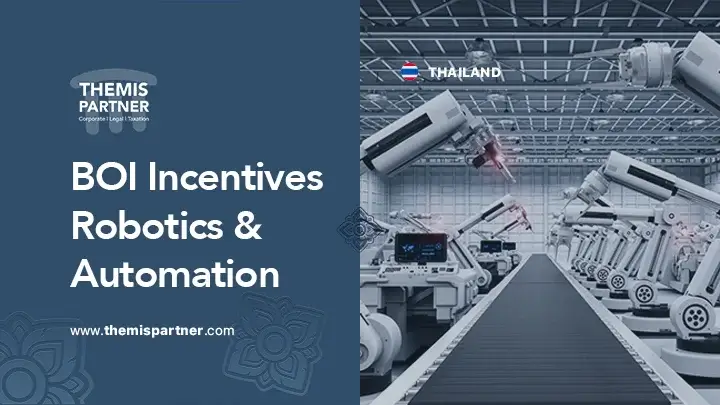How BOI Drives Industry Growth is set to transform the nation’s economic future, with the market projected to reach USD 19.6 billion by 2025.
Are you ready to capture new investment advantages as Thailand positions itself as Southeast Asia’s go-to hub for advanced automation?

Strategic policy, decisive tax incentives, and a skilled workforce are converging right now, making Thailand an attractive location for robotics firms and investors.
The Board of Investment’s (BOI) streamlined approvals, world-class infrastructure in Eastern Economic Corridor zones, and targeted talent programs are lowering barriers for both new entrants and established leaders.
Key Takeaways
- BOI’s robust investment incentives include up to 8 years corporate tax holidays and customs duty exemptions, directly reducing setup costs for robotics and automation projects.
- Eastern Economic Corridor (EEC) advantage gives investors fast-track approvals, land ownership rights, and priority infrastructure access, accelerating both market entry and scalability.
- Targeted BOI grants and training partnerships empower robotics firms to access state-funded upskilling programs and collaborate with universities for advanced talent pipelines.
- Thailand’s robotics market is surging, projected to rise from USD 19.6 billion in 2025 to USD 38.4 billion by 2031 (CAGR: 11.8%), pulled by manufacturing, electronics, and logistics sectors.
- Key industry opportunities center on automotive, electronics, food processing, and logistics, each benefiting from BOI-backed automation and rapidly growing export markets.
- Streamlined one-stop investor services through TIESC deliver licensing and visa approvals in as little as 40-60 working days, ensuring quick project launches for foreign robotics firms.
- Localization is critical for resilience, with BOI offering additional tax breaks for projects that use high local content and invest in local supply chains.
- Workforce development and regulatory compliance are essential action steps, with firms urged to prioritize talent retention, intellectual property protection, and local sourcing for long-term success.
Table of Contents
-
BOI’s Role in Robotics & Automation (2025)
-
Robotics & Automation Opportunities and Risks
-
Incentives & Support for Robotics Investors
-
Leading Sectors for Robotics Adoption
-
Trends & Innovation in Thailand Robotics (2025)
-
FAQ: BOI Robotics & Automation
-
Conclusion
BOI’s Role in Robotics & Automation (2025)
Thailand as a Regional Robotics Leader
Thailand’s Board of Investment (BOI) aims to position the nation as Southeast Asia’s robotics and automation hub by 2025. The strategic vision aligns with “Thailand 4.0” and “Industry 5.0” initiatives, targeting high-tech manufacturing, industrial AI, and digitalization.
BOI’s key focus areas include:
- Fostering innovation through R&D incentives and technology transfer partnerships.
- Supporting sector-specific education and workforce training for robotics talent.
- Strengthening international collaborations and attracting leading global robotics firms.
- Implementing infrastructure upgrades in zones like the Eastern Economic Corridor (EEC) to facilitate advanced manufacturing.
For a deeper overview, visit the Thailand Board of Investment official site.
BOI’s 2025 Initiatives & Targets
BOI’s 2025 initiatives deliver decisive incentives for robotics investors, such as:
- Tax holidays of up to 8 years and customs duty exemptions for robotics and automation projects.
- Special privileges in EECi and EECd, including land ownership and streamlined foreign talent visas.
- Additional tax reductions for projects using high local content, boosting the domestic supply chain.
Combined, these measures support a projected robotics market surge from USD 19.6 billion in 2025 to USD 38.4 billion by 2031, with targeted adoption rates in automotive, electronics, and logistics sectors.
Robotics & Automation Opportunities and Risks
Top Opportunities for Robotics Companies
Thailand’s surge in robotics & automation is centered on high-demand industries and a supportive innovation ecosystem. The most immediate opportunities are found in:
- Manufacturing, especially automotive and electronics, which lead robotics adoption for assembly, welding, and inspection
- Agriculture and food processing, leveraging automation for labor-intensive tasks and export-driven growth
- SMEs developing unique robotics solutions, supported by rising local talent and new BOI incentives
Labor shortages and pressure for operational efficiency are pushing companies to automate now. For detailed industry reports, visit the International Federation of Robotics.
Challenges and Risks in 2025
Robotics firms should also prepare for several challenges:
- Difficulty in sourcing skilled engineers, limiting advanced development
- Regulatory complexity and the need for precise compliance, especially with IP protection
- High dependency on imported critical components, risking delays and cost fluctuations
- Intense competition between foreign and local robotics firms, particularly in high-tech sectors
Clear action steps: align with BOI compliance, invest in workforce development, and localize supply chains for long-term resilience.
Thailand’s robotics sector offers robust growth, driven by policy and strong demand, but success depends on navigating talent, regulatory, and supply chain challenges.
Incentives & Support for Robotics Investors
Tax, Grants, and Regulatory Benefits
Robotics & Automation in Thailand: How BOI Drives Industry Growth is defined by a clear suite of 2025 incentives designed for investor impact. Eligible projects can access:
- Up to 8 years corporate income tax holiday, plus further reductions for industry-specific upgrades
- Complete import duty exemptions on equipment and raw materials
- Special tax breaks for sustainability and verified local content use (notably in electric vehicles and electronics)
- Access to government grants for R&D, advanced automation, and workforce upskilling initiatives
Recent BOI statistics show that several high-tech robotics firms received expedited approval in 2024, encouraging similar applications in 2025.
BOI’s Streamlined Investor Support
The Thailand Investment and Expat Services Center (TIESC) delivers single-window efficiency for investors. Its services include:
- One-stop approval for licensing, foreign visas, and corporate registrations
- Fast-track processing for R&D projects and tech licensing
- Flexible talent mobility support to bring skilled engineers and researchers into Thailand
With robust fiscal incentives and streamlined entry via TIESC, robotics and automation investors in Thailand can scale faster, reduce upfront costs, and operate with confidence in 2025.
Leading Sectors for Robotics Adoption
Industries Driving Robotics & Automation
Industries propelling robotics & automation in Thailand include automotive manufacturing, electronics, logistics, food processing, pharmaceuticals, and agriculture.
Significant examples reveal adoption across:
- Automotive and electronics: Automated assembly and inspection lines, with firms like Omron and KUKA operating BOI-backed facilities.
- Logistics: Warehouse robotics for pick-and-place operations, adopted by leading e-commerce operators.
- Food and pharma: Precision robots handling packaging and labeling for export-grade safety.
BOI’s targeted grants and tax incentives accelerate project viability in each sector.
Advantages of Targeting Key Sectors
Targeting these sectors means leveraging:
- Access to vast local and ASEAN export markets
- Robust infrastructure in EEC zones and digital parks
- BOI’s support for industry clusters and supply chain localization
Collaboration frameworks connect:
- Research centers and universities with private manufacturers
- Government programs with global technology leaders
Thailand’s data-driven, cluster-supported approach equips investors with practical partnerships, privileged access, and growth scalability, all cornerstones for capturing Asia’s robotics market opportunity.
Trends & Innovation in Thailand Robotics (2025)
Market Trends Shaping Growth
Robotics & Automation in Thailand is accelerating through targeted trends with immediate business impact.
In 2025, key developments include:
- Widespread adoption of collaborative robots (cobots), AI-driven systems, and Robotics-as-a-Service (RaaS) models.
- Green robotics initiatives that integrate energy efficiency and sustainability into automation workflows.
- Digital transformation using big data, driving smarter manufacturing and competitive output.
Statistically, the industrial robotics market in Thailand is projected to grow from USD 19.6 billion in 2025 to USD 38.4 billion by 2031: an annual growth rate near 12%.
Workforce and Tech Impact on Competitiveness
Thailand is investing heavily in human capital to sustain this trajectory. Key strategies include:
- National upskilling and re-skilling programs to meet advanced automation demands.
- BOI-sponsored partnerships with universities and international tech leaders to deliver sector-specific training.
- Strong public support for tech-driven SMEs and local champions.
By supporting these trends, the BOI strengthens Thailand’s role as a regional leader.
Thailand’s robotics surge is built on skilled people, innovative policies, and a proven commitment to sustainable, tech-enabled growth.
FAQ: BOI Robotics & Automation
How fast is BOI approval for robotics projects?
Applicants typically receive decisions in 40–60 working days if their documents are complete and all criteria are met.
Most robotics investments qualify for expedited processing in strategic Eastern Economic Corridor (EEC) zones, helping accelerate market entry.
Can foreign robotics firms fully own land in Thailand?
Yes, foreign investors, particularly in EECi and EECd may qualify for:
- 100% foreign ownership privileges
- Land ownership rights for business operations
These measures are designed to level the playing field for global competitors and support long-term commitments.
Which robots and applications are most in demand?
Robotics & automation in Thailand is accelerating fastest in:
- Industrial robots for automotive and electronics
- Collaborative robots (cobots) in logistics
- Processing robots for food and packaging sectors
Are there government-backed robotics training programs?
The BOI works with universities and technical colleges to fund:
- Robotics-specific upskilling programs
- Industry-driven vocational training
- International exchange initiatives aimed at technical talent
A well-prepared application and awareness of current BOI zones can reduce approval timelines and widen access to strategic incentives, making Thailand a responsive market for global robotics leaders.
Conclusion
Thailand’s BOI-driven robotics surge presents a powerful path for you to sharpen operational efficiency, tap new incentives, and gain a strategic edge in Asia’s high-growth industries. Fast-track your investment by aligning with BOI programs, prioritizing workforce development, and localizing your supply chain for resilience.
Take the next step with confidence, contact us for tailored guidance on site selection, BOI compliance, and structuring turnkey setups that maximize available incentives. Themis Partner ensures your entry and expansion are seamless, compliant, and optimized for success.
